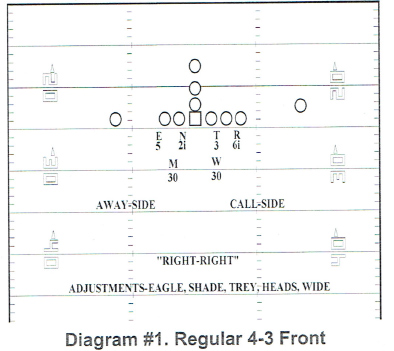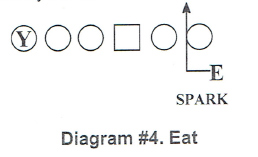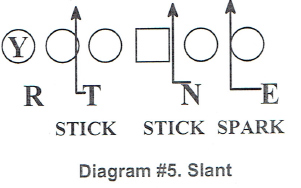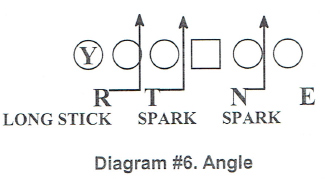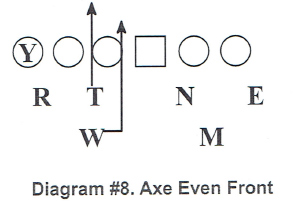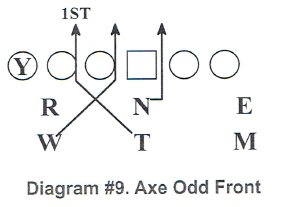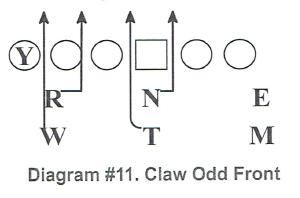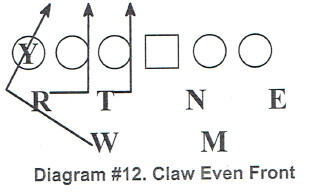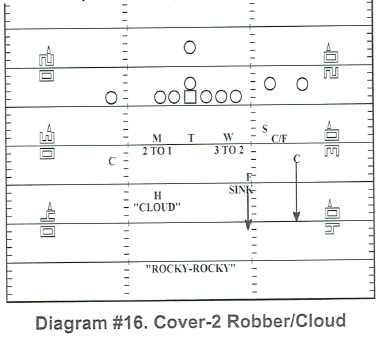|
Meshing the 3-3 and the 4-2 Defenses By: Joe Henrick - Bethlehem Catholic HS (PA) Originally Published - Nike 2014 Coach of the Year Clinics Clinic Notes - by Earl Browning
However our coverage remained the same as the 4-2-5 defense. The man-pressure scheme was the same. Although we went to an odd man front, the defensive line and linebackers techniques remained the same. We had the same principles and development areas. We have four principle areas, which we addressed with the mesh of the defensive schemes. In any defensive scheme, the first principle is to stop the run. DEDICATED TO STOPPING THE RUN • 8-man Front The scheme allowed the defense to attack with an eight-man front and outnumber the blockers. MULTIPLE BUT SIMPLE • Front 6 The front looks complicated to the offense but is simple to run. There are multiple looks you can give the offense without changing your teaching. The positions are mirror positions, which cuts down on the teaching and allows players to play in different positions without additional instructions. We have run a four-man front forever. We knew exactly how everyone was going to try to block us. When we meshed the 3-3-5 with what we did. I did not know how the offense was going to try to block us. I had to study and become comfortable with the scheme. Once the coaches are comfortable in the scheme, the players will feel comfortable with it. PRESSURE MENTALITY • Speed The 3-3-5, put an extra secondary player on the field and the defense became faster. Speed makes the defense harder to block. When you increase the amount of speed on the field, you increase the threat of a blitz. It forces the offense to beef up their protection schemes and revise their blocking assignments because the blitz comes from different angles and positions. GREAT DISGUISE • Constant Shell Look The last principle is important to me. It gives you great disguise in the secondary. You have a constant shell look. If you are in man-coverage or zone coverage, the look is the same. The coaches teach in developmental areas. I challenge my coaches to develop their players in these areas. The first development area is fundamentals. In the fundamental area, we teach alignment, assignment, and communication. The second area is techniques. In that area, they teach the first level players stance, get-off, attack, and react. In the secondary, the coaches teach stance, key and recognition, and then react. The third area of development is effort. That includes escape from a block, pursuit, and tackling. I challenge the coaches to make their own practice plan around those areas of development. What they do in practice must teach those development areas. The players can improve in escape, pursuit, and tackling by improving their effort. Not everyone can have great skills, but everyone can give great effort. That is how we develop our defense. This area is important in dealing with players. If a player wants to know why he is not playing, using these areas we can explain it to him. You can tell him his strengths and weakness as it relates to the development areas. The reason he is not playing is fundamentals, techniques, or effort. The next thing we get into is logistics. How do we move from the even to the odd front? I am not saying this is the way to do it. I am saying we do it this way. The first year I was at Bethlehem our defense was worse than terrible. Last year we improved and this year we were okay. We must get better on defense. This year we gave up 14 points a game. We must bring that statistic down. LOGISTICS Switching Between Fronts When playing the four-man front, we call that regular personnel. When we play the three-man front. we call that nickel personnel. We can set the front in a number of different ways. We declare according to the strength of the formation. We can set the front to the tight end or split end. We can set it to the strength or weak side of the formation. We can set it to the field or boundary and to the running back set in the backfield or opposite (Oppie) his set. The direction identification deals with our personnel. To our call side, we align the Rock, Tackle, and Whip (Will) linebacker. To the away side are the End, Nose, and Mike linebacker. That is our front six defenders. The huddle call is the same for both fronts. If I call "Tight Blade — Red" it is the same call for the odd or even fronts. The front knows how to align by the call "nickel, nickel, nickel." If they hear the nickel-call, they are in an odd three-man front. If they hear "regular", they know it is a four-man front. The nose is protecting the same gap in the odd or even front. If his gap responsibility in the odd front is the weak side A-Gap, it is the same responsibility in the even front. If he is head up the center, his responsibility is the same as if he were head up the guard.
When we call our techniques, we use the same terminology as most people. (Diagram #1) We call everything in a head up position as an even number. If the technique is a shoulder position, it is an odd number. If it is an inside shade position, we call it an "even-i." position. In the four-man front, we align in a 6i, 3, 2i, and 5-techniques for the down linemen. Our call side in the diagram is the defensive right. To that side the "Rock" aligns in a 6i-technique on the inside eye of the tight end. The tackle is a 3-technique. The Whip linebacker aligns in a 30-alignment stacked behind the tackle. Those three travel together to the call side. The away side is to the left. To that side, the nose aligns in a 2i-technique on the inside shoulder of the guard. The end aligns in a 5-technique on the tackle and the Mike linebacker aligns in a 30-technique on the outside shoulder of the guard at linebacker depth. The 6i-technique aligns on the tight end but his key is the offensive tackle to his inside. If he aligns in a 5-technique or 6i-technique, his read is the same. If the call from the sideline is tight, the call side is to the tight end. If we call field, with the ball on the hash mark, the call is the wide side of the field. We play the open side 5-technique different ways. We can align him at an angle with a wide alignment. He can play a normal shade technique with an inside foot to crotch alignment on the tackle. We travel with our call side and away side. However, it is not necessary for you to do that. This year, with our nickel front, we did not move anyone. In the three-man front, we substitute for the tackle. (Diagram #2) The nose plays a 0-technique on the center. The Rock and end play 5-techniques on the offensive tackles. We still refer to the player we bring into the game for the tackle as a T-player. We refer to him as the -Tom" linebacker. The Whip linebacker goes to the call side and the Mike linebacker is to the away side. They are stacked behind the 5-techniques at linebacker depth. The Tom linebacker stacks behind the nose at linebacker depth.
Every blitz or line movement is the same responsibility in both fronts. The only one who must learn something new is the substitute for the tackle. He has to learn the blitz gaps. However, if the Mike linebacker has a blitz call, he goes to the same gap regardless of the front. The linebackers have the same keys regardless of whether we align in the 3-3 or the 4-2. In the 4-2, the Mike and Whip linebacker key through the guards and flow off the backfield action. What they read is high-hat. low-hat, or pulling technique. If they read low-hat, their fit comes from the backfield action. If they read high-hat, they check for draw and drop to their pass responsibility. The Mike linebacker in a 4-2 front is a B-Gap player. He aligns on the outside shoulder of the offensive guard and plays through the guard. If he sees a down block, by the offensive guard he attacks the line of scrimmage and spills everything to the outside. In the 3-3 front, he aligns in a 50-stack position, but still reads the guard and is a B-Gap player. If he sees low-hat with a down block. he attacks the line of scrimmage and spills everything. He has the same key from both fronts. His key and fill is exactly the same in both fronts. The Whip linebacker has the same technique as the Mike linebacker. He reads the guard and reacts to what he sees. The Tom linebacker in the middle stack in the 3-3 is technically a playside A-Gap player. However, he is a sideline-to-sideline player and overlaps with the outside linebacker in his responsibility. His rule is to attack the A-Gap. If it is closed, he keeps moving to the outside. If there is a fullback in the set. he mirrors his movement. If the fullback tries to enter the A-Gap and isolate him, he takes the fullback on with his outside shoulder and spills the ball to the Mike linebacker. The nose guard technically has the backside A-Gap, but play with leverage to the backside. He does not step into that gap, unless he is on a stunt. The Rock and end align in a 5-technique and are C-Gap players. The next thing we get into is our line movements from the two fronts. We identify the movement by letter and word associations. We use the terms slant and angle. A slant is to the call and an angle is away from the call. Rat movement is by the Rock defender. Eat is the same movement for the end. Pinch is what it says it is. The pinch is an inside movement by the down four in the 4-2 front and an inside pinch by the Rock and end in the 3-3 front. The first movement is Rat/Eat. (Diagram #3) The Rock runs the Rat stunt. Rat stands for "Rock Across Tackle." In the 4-2 front, he "long sticks" from the 6i-technique across the offensive tackle into the B-Bap. The "long stick" technique is different from the "spark" used by the end on the "Eat" movement. On the "long stick" movement, he slants and gets into the B-Bap. On a "spark" movement, the lineman takes a lateral step and blows through the gap.
In the 3-3 front, the Rock in the Rat movement is still going into the B-Gap. However, since he is going from a 5-technique instead of a 6i-technique, he uses a spark movement instead of a long stick. The word means the same in a 4-2 as it does in a 3-3, but the technique is different. Eat stands for "End Across Tackle." (Diagram #4) In the 4-2 with no tight end to his side, the end sparks from a 5-technique into the B-Bap. The Rock and the end are going to the B-Gap, but they use different techniques because of the distance they cover.
The next movement is the slant/angle. (Diagram #5)
If the movement call is "slant", the down linemen slant in the direction of the strength call. If the call is "right", on a slant, the defensive line slants to the right. The defensive end to the side of the movement plays a base technique. On a right slant, the Rock-end plays base. On the slant call, the 3-technique tackle does what we call a "stick" technique. He does not move from a B-Gap alignment to a C-Gap alignment. The Rock plays base, which means he is the C-Gap defender. The tackle lateral steps and fires through the inside shoulder of the offensive tackle. He sticks the gap. The nose does the same technique in the weak side A-Gap. The end in the 5-technique does a spark technique into the B-Gap. If the call was "angle", the defensive line angles away from the call. (Diagram #6) If the call is right, they go left. On a right angle, the left defensive end plays base because he is to the side the angle is coming. The Rock-end in the 6i-technique long sticks into the B-Gap. The tackle and the nose use a spark technique to get into their adjacent gaps.
In the 4-2 front, we have three down linemen going to or away from the call. In the 3-3 front, we have two linemen moving to or away from the direction call. On the pinch stunt, we have two ways we can call the movement. We can call double, which is what the diagram shows. The four down linemen, pinch one gap to the ball. (Diagram #7)
The Rock-end has to use the long stick to get into the B-Gap. The tackle sparks into the A-Gap. The nose uses a stick technique to the backside shoulder of the center and the end uses a spark into the backside B-Gap. We can pinch one side or the other. If we want the call side to pinch, we can call that. If we want the away side to pinch, we can do that. We have three pressure packages. We have axe, blade, and claw. It is simply, A-Gap = axe. B-Gap = blade, and C-Gap = claw. If we call the blitz, it is a call side stunt. If we want to run the blitz to the away side, we call the blitz -away". We call "axe-away." That means we run the axe blitz away from the call. If we call an axe blitz to the call side, the Will linebacker blitzes the A-Gap. (Diagram #8) The 3-technique aligned in the B-Gap knows the blitz does not affect him. He plays his base defense. The "away-axe- is the same movement with the nose and Mike linebacker.
If the front is a 3-3 front, the Tom linebacker blitzes through the B-Gap. (Diagram #9) The reason he does that is the tackle's responsibility in the 4-2 front is the B-Gap. The Tom linebacker goes first blitzing the B-Gap. and the Will linebacker crosses behind him into the A-Gap. If we want the Will linebacker coming first and the Tom linebacker coming behind him, we simply call "axe-switch.' The nose knows he has weakside A-Gap and sparks into that gap.
If there is a defensive lineman aligned in the gap where the blitz is coming, he has to get out. On an axe-away from the 4-2 front. the nose in his base alignment aligns in the A-Gap. He knows the Mike linebacker is coming into that gap. He sparks into the B-Gap. On the axe-away, the middle linebacker blitzes the strong side B-Gap as he did on the axe to the strong side. The reason the middle linebacker goes to the strong side B-Gap is he is the playing the responsibility of the tackle in the 4-2 defense. In the 3-3 front, on a blade blitz, the Tom linebacker attacks the call side A-Gap and the nose goes opposite into the weak side A-Gap. (Diagram #10) The Will linebacker blitzes the B-Gap and everyone else plays base defense. If we run the blade blitz to the away side, the nose sticks the A-Gap and the Mike linebacker blitzes the B-Gap. The Tom linebacker blitzes the strong side B-Gap and the Will linebacker is the free runner to the A-Gap and weak side.
If we run the blade blitz from the 4-2 front, the 3-technique tackle know he has to get out of the B-Gap. He sparks inside into the A-Gap and the Will linebacker blitzes the B-Gap. On the blade blitz to the away side, the nose and Mike linebacker fires their gaps. The claw blitz is a C-Gap blitz by the outside linebackers. It is an edge stunt. (Diagram #11) In the 3-3 front, the 5-technique Rock-end sparks into the B-Gap and the Will linebacker blitzes the C-Gap. On this blitz, the Tom linebacker attacks the strong side A-Gap and the nose goes opposite his charge.
In the 4-2 front, there is more movement. (Diagram #12) The Rock-end and tackle must move one gap inside. The Rock-end long sticks into the B-Gap and the tackle sparks into the A-Gap. The Will linebacker moves and blitzes the C-Gap. It is a three-man movement to the call side and a two-man movement to the away side.
If we run an axe, blade, or claw, we have a five-man pressure package. However, if you want to bring six-man pressure, we double up the calls. We can call double axe, blade, or claw and have a six-man pressure scheme. The double-axe call is the hardest of the movement from the 3-3 front. (Diagram #13) To the call side, the Tom linebacker blitzes the B-Gap and the Will linebacker comes behind him in the A-Gap.
To the away side, the nose has to long-stick into the B-Gap, which is difficult because of the distance. The Mike linebacker comes second in his blitz sequence behind the nose going into the A-Gap. The blitz from the 4-2 is not as difficult. The nose has to move from the 2i-technique into the B-Gap, which is a lateral step movement. Another way to run a six-man pressure is to combine two blitzes. If we want to run the axe to the call side and a blade to the away side, we call "axe-blade.- The blitzes run in the order we call them. We said axe first and blade second. That means axe is a call side blitz and blade is an away side blitz. If we say, blade-axe, the blitzes reverse. The main coverages we play are 2-Deep Robber, 2-Deep, Man-free, and 3-Deep. We play with three safeties and two corners. Our strong safety is Sam, the weak safety is Hawk, and Free is the free safety. When we signal in our defense, we signal to the front and linebacker and the secondary separately. They get separate calls and the linebackers never get a coverage call. They are involved with the blitz game. If they are not blitzing, they play man-to-man on the remaining back in the backfield. Our 2-deep robber coverage originated at Virginia Tech (Diagram #14). In our scheme, we want to be in an eight or nine-man front. The corners are going to cheat and push deep into halves of the field. The outside safeties are flat to wheel players. They are responsible for the three-step patterns to the outside or the wheel route by the number-2 receivers. The free safety is the "robber" and he is the ninth defender in the box.
He is a fiat-footed player in the middle. He reads the number-2 receiver and plays the alleys on both sides. If the number-2 receiver goes vertical, he locks up with him. If number-2 goes outside, he robs the curl area. If the number-2 receiver goes across the field on a drag or deep cross, he goes with him. That is how we start the coverage. The Will linebacker to the strong side plays the number-3 receiver to the number-2 receiver. The number-3 receiver is in the backfield. If he releases. the Will linebacker has him. If he blocks, the Will linebacker helps on the number-2 receiver. In a 2 X 2 formation with a tight end, the Hawk aligns in what we call a D-9 (D-Gap). (Diagram #15) That is nine yards deep on the outside shoulder of the tight end. He disguise his coverage by walking down and back in his alignment. We play a rolled up cover-2 against this alignment. The corner to his side is the primary force players on a run and has flat to wheel on the pass. On the two-wide receiver side we play the Sam safety as a flat to wheel player.
The free safety reads the slot receiver and plays him as he did before. The corner to that side is the half player. The front does not matter on the coverage. It does not make any difference if we are in the three-man front or the four-man front. The coverage has nothing to do with the front. In this coverage, the Will linebacker drops and plays the number-2 to number-1 receivers. The Mike linebacker drops and plays number-3 to number-2 receiver in his progression. In our alignment, the corners align at one-yard inside the wide receiver and seven-yards deep. The free safety aligns on the tight end. He is in the B-Gap to that side at nine-yards deep. If the tight end splits or there is a second wide receiver, he aligns in a D-9 alignment. The strong safety aligns in a four-by-four yards alignment on the tight end. The Hawk safety is at the D-9 position on the other side. Against the 3 X 1 set, to the three-receiver side, the corner aligns on the number-1 receiver and has him on all vertical routes. (Diagram #16) The Sam safety aligns on the number-2 receiver and plays with a flat-to-curl drop. The free safety aligns on the number-3 receiver and sinks into his coverage. He has number-3 vertical and on all crossing routes. If he releases outside, the Sam safety sinks and plays football.
To the single receiver side, we play a cloud adjustment. The corner rolls and the Hawk safety drops into the half-field. We can spin the coverage from the backside. The corner plays the single receiver man-to-man and the Hawk safety pushes to the middle into the hole. He takes the number-3 vertical and the free safety plays robber to the three-receiver side. From this alignment, you can play two-deep with man-coverage under it. You can play 2-deep with some kind of bracket coverage between the Sam and free safeties. This coverage allows you to play with all your linebackers in the box. You can easily play cover-3 from this scheme. I hope you got something out of this you can use. I appreciate you being here. Thank you.
|




